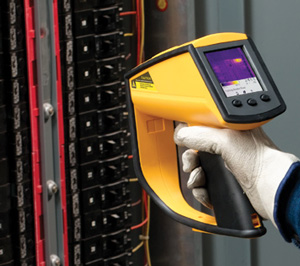 Faulty electrical connections or overload conditions in switching systems, electrical distribution boxes and electric drives can lead to costly production downtimes or even fire damage. The regular inspection of all electrical installations with a precise Testo-thermal imager helps to minimize this risk of standstill.
Faulty electrical connections or overload conditions in switching systems, electrical distribution boxes and electric drives can lead to costly production downtimes or even fire damage. The regular inspection of all electrical installations with a precise Testo-thermal imager helps to minimize this risk of standstill.
The reason thermography is so applicable to the monitoring of electrical systems is that new electrical components begin to deteriorate as soon as they are installed. Whatever the loading on a circuit, vibration, fatigue and age cause the loosening of electrical connections, while environmental conditions can hasten their corroding. Briefly stated, all electrical connections will, over time, follow a path toward failure. If not found and repaired, these failing connections lead to faults.
Fortunately, a loose or corroded connection increases resistance at the connection and since increased electrical resistance results in an increase in heat, a thermal image will detect the developing fault before it fails.
Thermal imaging cameras detect radiation in the infrared range of the electromagnetic spectrum (roughly 9,000–14,000 nanometers or 9–14 µm) and produce images of that radiation, called thermograms. Since infrared radiation is emitted by all objects above absolute zero, thermography makes it possible to see one’s environment with or without visible illumination. The amount of radiation emitted by an object increases with temperature; therefore, thermography allows one to see variations in temperature. Maintenance technicians use thermography to locate overheating joints and sections of power lines, which are a sign of impending failure.
Detecting and correcting failing connections before a fault occurs averts fires as well as impending shutdowns that can be critical to manufacturing, commercial and institutional operations. Such predictive actions are important because when a critical system does fail, it inevitably increases costs, requires the reallocation of workers and material, reduces productivity, threatens corporate profitability and impacts the safety of employees, customers and/or clients.
The best solution is to create a regular inspection route that includes all key electrical panels and any other high-load electrical connections.
Advantages of thermography:
- It shows a visual picture so temperatures over a large area can be compared
- It is able to find deteriorating, i.e., higher temperature components prior to their failure
- It can be used to measure or observe in areas inaccessible or hazardous for other methods
- It is a non-destructive test method